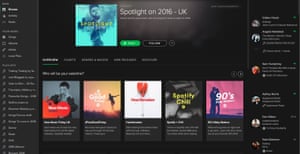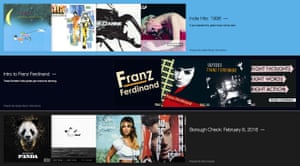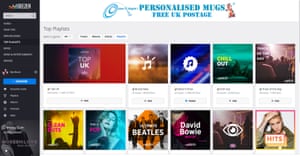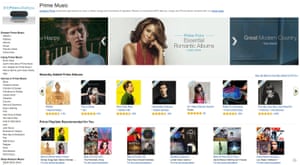
Music streaming is on the rise: in 2015 in the UK fans played 26.8bn songs on audio-streaming services alone, with another 26.9bn streams of music videos on services like YouTube.
There are a cluster of services competing for our time and cash. But which is the best for your listening habits? We’ve compared five of the best known on-demand music-streaming services.
Some features are standard: catalogues of 30m-40m tracks (except Amazon Prime Music); themed playlists created by in-house teams of tastemakers; and the ability to store tracks on your mobile devices for offline listening.
But what other features tip the balance? Read on for our comparison, as well as a summary of some of the other contenders worth trying.
Spotify

Price: Free or £9.99 a month
It’s perhaps no surprise that Spotify is the most well-rounded streaming service: it launched in 2008 and has been steadily improving since then. Many of the new features added in the last year or two have focused on helping you discover music.
Playlists are key to that: Spotify has a wide range that are updated with new songs every week, but it also has a deep catalogue of playlists created by outsiders: labels, media, musicians and fans. Follow a few, and you’ll have a regular supply of new tunes.
Every Spotify user gets their own Discover Weekly playlist too, updated every Monday with 30 new songs that its recommendation algorithms think you’ll like, based on your own tastes and those of people like you. It’s an excellent idea.
On mobile, Spotify’s Now feature suggests playlists based on your habits and the current time of day, while its Running mode will play you tracks that match your jogging pace.
It has added audio and video podcasts as well as YouTube-style short-form video shows recently, although the jury is out on whether people want to watch Spotify as well as listen to it.
Spotify has better social features than its rivals, with the ability to add friends and see their playlists and listening, as well as a built-in messaging system to ping music back and forth. Creating and sharing your own playlists is easy too.
Another strength is the system for following musicians’ profiles and getting notifications when they have new music out. A recently introduced Concerts feed shows you upcoming, nearby gigs by artists you’ve listened to, which is useful.
It has good support for devices beyond the desktop and mobile: it’s available on Sony’s PlayStation 4, Sonos hi-fis and through Google’s Chromecast and Amazon’s Fire TV, while its mobile app plays nicely with Apple TV too.
Spotify’s free tier has audio advertising, but is missing offline listening and – on mobile – the ability to pick tracks on-demand, although you can play an artist’s catalogue on shuffle mode. Pay £9.99 a month, and you get full access (including offline), no ads, and a higher-quality streams option.
Where Spotify falls down is its family plan, which is more expensive than rivals. You can add up to four extra accounts for £4.99 each, but that means you’ll pay £29.95 a month for a family of five compared to Apple Music and Google Play’s £14.99 for six.
Verdict: the best of the bunch for now, especially for music discovery, with new features being added at a rapid pace.
Apple Music

Price: £9.99 a month
Apple Music launched with great expectations in the summer of 2015, but early gremlins involving people’s iTunes collections and unflattering comparisons with Spotify drew criticism.
Even so, Apple raced to 10 million paying subscribers six months after launch – a milestone it took Spotify nearly six years to reach – so Apple Music is catching on. It’s also much better than its harsher critics claim.
Its programmed playlists are a strength, with a deep collection of playlists from Apple’s own staff and guest curators that mines some refreshingly-unusual niches. The introductions to specific bands’ back catalogues are particularly good.
The more you use Apple Music, the more it gets to know your tastes, serving up album and playlist suggestions in its For You section with relatively few clunking-great misfires. The way it integrates your existing iTunes collection, now that the early bugs have been fixed, is good too.
Live radio station Beats 1 may not be a massive revelation to Brits used to the BBC’s specialist radio output – it’s part Radio 1’s evening shows and part 6Music – but elsewhere in the world this has been a breath of fresh air. Shows helmed by artists like Josh Homme, St. Vincent, Dr Dre and Q-Tip are well worth tuning in to – and more so now that you can access them on-demand, which you couldn’t at launch.
Another unique feature, Apple Music Connect, remains a misfire. It could be brilliant: a mix of Twitter, Instagram and SoundCloud where musicians post exclusive stuff including raw demos. Few are using it to that extent yet, though.
Dedicated iTunes haters won’t enjoy Apple Music’s interface, but navigating your way around isn’t too hard, even if creating playlists is a pain. It’s less social than Spotify too: there’s very little sense of what your friends are listening to.
Apple was early on to the family plan idea: pay £14.99 a month and you can have up to six people on your account. Needless to say, Apple Music works well on Apple TV, its recent launch on Sonos was welcome, and contrary to expectations, its Android app is pretty slick too.
Verdict: room to improve, but for heavy iTunes users firmly embedded in Apple’s ecosystem, it’s made a good start.
Google Play Music

Price: £9.99 a month
Google’s biggest music-streaming service is YouTube, but its audio-only Google Play Music is building its own following.
The service has a neat, stripped-down design: plenty of white space in contrast to Spotify’s darker design. Searching artists, albums and tracks is easy, as is creating your own playlists.
There’s a good introduction feature that asks you for your favourite genres and artists, which will help tune Google Play’s recommendations for playlists, albums and radio-style stations. The playlists and stations are good, based – like those on rivals – around specific genres, themes and activities.
Google Play mirrors Spotify’s Now feature in the way it will suggest playlists for the current time of day: a Thursday afternoon might throw up Sitting In A Coffee Shop, Focusing While You Work and Boosting Your Energy as themes, for example. Pick one, and you’ll be asked for a genre, and then given a choice of three suitable playlists.
Like Apple Music, Google Play’s stations can be surprisingly specific: Ambient Scandinavian Stargazing, Sad Rappers and Girl Hold My Earrings – the latter specifically for women spoiling for a fight after someone has stolen their man. Contrary to what you might expect of Google, there’s a very human touch to all this.
More stereotypical is the lack of many social features beyond the ability to share your playlists on social networks. As with Apple Music, what your friends are listening to and recommending is something you’ll have to find elsewhere.
For anyone using Google’s cloud-music storage service, Google Play Music works seamlessly with that: you can upload your downloads collection – most easily by dragging and dropping it in the Chrome web browser – with space for up to 50k songs.
A nice touch is the way it pulls in music videos from YouTube: for example, when you’re listening to an album, it suggests the videos from its tracks.
In the UK, after its three-month free trial, Google Play Music costs £9.99 a month, although in the US it has a free tier focusing on the radio-style stations, which may launch elsewhere in the world soon. Its £14.99-for-six-people family plan matches Apple’s, and is available in the UK, Australia, Canada, France, Germany and the US.
Verdict: neat design and some characterful playlists to discover, although it could be more social.
Deezer

Price: Free - £9.99 a month
Until Apple Music’s 10m milestone, Deezer was the second biggest on-demand streaming service. It’s the one with the widest global reach, and has signed up many of its users through deals with mobile operators bundling it into mobile contracts.
Deezer does all the basics well, and has improved on the recommendations side, albeit not as rapidly as Spotify. The service promotes playlists from its own editors, outside labels and other curators, organising them by genre.
Its Mixes feature is useful too, blending the songs you like with its own recommendations. These radio-style stations are based on genres and themes, like its rivals: Happy Hour, Sad Songs and Cosy Fireplace among more standard themes.
If you prefer simply hitting the play button and sitting back, Deezer’s Flow feature is welcome: a mix tuned to your tastes based on the songs and artists that you’ve favourited, which learns from the tracks you mark as liked or unliked while it plays. It’s less of a pipeline for brand new music than Spotify’s Discover Weekly, but more about a flow of familiar tracks and artists.
Deezer works on Sonos and Chromecast, and will play through your Apple TV from its iOS app too. If it has a unique selling point in 2016, it might be its push into non-music content.
It has a good collection of news and entertainment podcasts, for example, and has even moved into football – the first music-streaming service to do so. In the UK, Germany and 14 other countries, you can listen to live match commentary provided by radio partners like TalkSport.
Football is one of the “apps” available through Deezer – essentially sub-sections of its website created by other developers – including music-discovery startups and some artists (David Guetta for instance). They’re usually another route into playlists.
Deezer recently launched a family plan in France matching Apple’s: €14.99 a month for up to six people. It’s launching elsewhere in the coming months. For Sonos owners, meanwhile, there’s the Deezer Elite hi-res version – the equivalent would be Tidal’s HiFi tier – for better audio quality.
Verdict: worth a look, but has some catching up to do with Spotify on features.
Amazon Prime Music

Prime Music isn’t a standalone streaming service. Instead, it’s part of Amazon’s £79-a-year Prime membership scheme, along with the Prime Video TV and film-streaming service, one-day delivery on products you buy on Amazon, and the Kindle e-book lending library.
Prime Music also stands apart from rivals in other ways. Its catalogue is much smaller for example: around 1.4m tracks rather than the 30m+ elsewhere. When searching for the latest albums from artists you like, you’ll often end up being pointed towards Amazon’s MP3 store to buy instead.
Amazon, however, isn’t going after the same kind of music fans as Spotify, Apple Music and the rest. Prime Music is pitched at an even more mainstream audience: people who’ll be as happy listening to an 80s Rock Anthems, Acoustic Commute or Whitney Houston’s Top Songs playlist as they are searching for specific music.
These curated selections are divided into Stations and Playlists, with the former based on specific genres and artists, with the latter adding in activities and moods too: the idea being to supply a stream of music to accompany what you’re doing right now.
One of Prime Music’s advantages is that it integrates everything you’ve ever bought from Amazon, including digital downloads but also CDs and vinyl if they fall under its AutoRip feature. Prime also sits alongside Amazon’s existing Amazon Music service, where you can store your downloads collection.
Although you can create your own playlists, the focus is more on adding songs and albums to your library – it’s a traditional-style music collection at heart. Amazon also commissions the odd exclusive, such as its Indie for the Holidays Christmas compilation, and a pair of children’s albums.
Amazon’s stations and playlists – if not its exclusives – are mirrored on the other streaming services, so keen music fans will likely go elsewhere. But this is an accessible option for everyone else, particularly if they already have a Prime membership.
Verdict: limited compared to standalone rivals, but knows its audience well.
Also worth a listen
Tidal is now co-owned by a starry group of artists, and is trying to make headway against its richer rivals. The odd exclusive from Prince and Rihanna aside, its main appeal is its higher-resolution tier – good for audiophiles.
Napster’s illegal days are long behind it: now twinned with US streaming service Rhapsody, the pair have 3m subscribers around the world, providing a decent alternative to Deezer in the middle-class of the streaming world.
SoundCloud remains free for now, with plans to launch a subscription tier later this year. It’s a hotbed of remixes, mash-ups and raw demos from artists and DJs, many of which aren’t available on the other streaming services.
8tracks and Mixcloud focus more on playlists and mixes, with the latter adding in spoken-word radio shows too.
Bandcamp made its name as a platform for independent artists to sell music directly to fans. It’s still that, but its app also enables you to stream all the music you’ve bought: a great way to support the indie artists you love.
YouTube is the world’s biggest music-streaming service by far, from music videos alone. In the US, it’s already launched the subscription-based YouTube Red, which bundles in a Google Play Music subscription.
source:theguardian